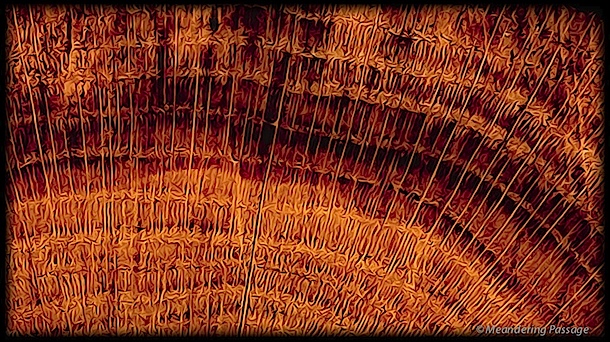
This playful abstract image is from a freshly sawed hardwood log end cut. The log had been soaked for days by snow, ice and freezing rain giving the rich tones and swollen wood grains. The original wood grain was of course not this pronounced or so tubular shaped — I enhanced this look in Photoshop with NIK Color Efex Pro and Topaz Clean.
From a little distance and a squint of the eye you can get nearer the original image’s appearance if you prefer that look. :-)
This photo was made in early January and I’ve been looking at it for weeks thinking, “There’s something in that image” but I couldn’t coax it out — until now. This weekend I tried some different croppings which spurred creativity.
When you know there’s something there but you can’t seem to place your finger on what it is, getting a fresh view even if by resizing, reshaping, rotating or simply ignoring the image for a while works wonders. Just don’t give up on it.
Discover more from
Subscribe to get the latest posts sent to your email.
An image with teaching capacity besides its beauty: Usually I am quite reserved regarding “artificial” enhancements and amplified saturation. But here it works well and brings to light those fine patterns, irregular in their regularity and seeming to extend into infinity. A fine image!
Thanks, Markus. I think with any artificial enhancements it works until it doesn’t. There’s a fine line sometimes between the two and it’s a matter of practice learning how to walk that line. I’m still learning, and often failing, but sometimes I get it right. :-)
What a great abstract – I love the glowing colours and the beautiful textures. You certainly found the essence of this picture! It’s true, I often have to put time and distance between myself and the photograph before it takes form in my mind properly.
Martina, thank you! Yes, often it’s a matter of giving the time to let the compass needle find true north. And sadly, sometimes it spins around madly. :-)
The color and texture really make this image special!
Steve, I like that…special. Thank you very much!
Pretty cool, Earl. It makes for a beautiful abstract.
PJ, yes, considering the original image I’m very happy with these results. Thanks!
There was a time when I felt I should not crop a photo because the 35 mm neg was so small. Crop in the camera, they used to say. I still think that’s good advice, but sometimes the image needs help. Isolate what is important and take out what is uninteresting. Then you end up with a better photo. This is very nice, Earl.
Ken, I certainly believe that first processing should be in the camera taking all efforts to capture what you see or envision as accurately as possible, and in those rare cases little additional processing may be required. But if you’re shooting to produce your own artistic work, I see nothing wring with “enhancing” an image.
Thanks!
I say “Hallelujah!” to your statement on enhancing an image. Why should photographers be forbidden to interpret what they see? No other artists are asked to sign that pledge. I don’t see why the use of a camera prohibits one from expressing creativity. As long we don’t call ourselves photo-journalists, I say, go for it! Especially if the results are as fascinating as yours!
Hi Anita…thanks!
I like it, Earl, and how you let it develop inside of you.